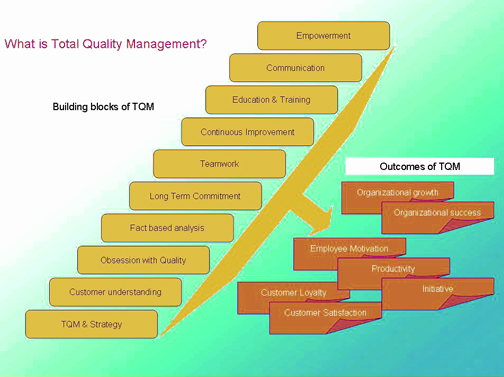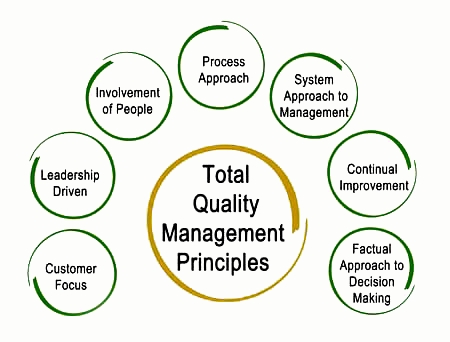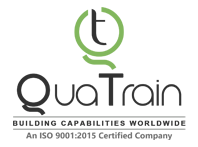
Total quality management (TQM) discovers a management system wherein a company arrives at organizational advancement through a commitment to customer requirements. A company can only meet those requirements when it empowers every employee in every function to maintain high standards and work for continuous improvement. Total quality management is that the precursor of the many quality management systems, like six letters of the alphabet, Lean, and ISO.
TQM is a company-wide initiative to involve everyone in doing the first time right for the customer.
“Do things right, the first time and every

![]() Customer Satisfaction
Customer Satisfaction
![]() Employee Commitment
Employee Commitment
![]() Fact-Based Decision Making
Fact-Based Decision Making
![]() Effective Communications
Effective Communications
![]() Strategic Thinking
Strategic Thinking
![]() Integrated System
Integrated System
![]() Process-Approach
Process-Approach
![]() Continuous Improvement
Continuous Improvement
Quatrain’s IT (Information Technology) training offerings include courses related to the Application, Design, Development, Implementation, Business Solutions, Maint
The roots of the principles and pattern of TQM extend back to the first 20th century and Frederick Taylor’s Principles of Scientific Management that advocated an even method of executing tasks and inspecting finished work to foreclose defective products from departing the shop. Advance innovation came in the 1920s with Walter Shewhart’s expansion of statistical process controls, which one could apply at any point in the production process to forecast quality levels. It was Shewhart who formulated the control chart which is used today.
During the 20s and 30s, Shewhart’s friend and mentee, William Deming, built-up statistical process control theories that he would eventually use to help the US Census department in the early 1940s. This was the beginning use of statistical process control in a non-manufacturing field.
Following the world war, early American quality theorists, including Deming, who would achieve hero status in Japan, notified Japanese industry on how to amend processes and output to reconstruct their war-shattered economy. At the time, the term which was made in Japan was similar with shoddy craftsmanship. As early as 1945, seers and electrical engineer Homer Sarasohn spoke about containing variation and supervising process to bring on best deliverables.
As a result, in the 1950s, quality became the proverb for Japanese manufacturing. Quality pertained not just management, but all levels of a company. In the 1960s, quality circles started coming out in Japanese workplaces and furnish employees the opportunity to talk about problems and consider solutions, which they then demonstrated to management. Commencing on the factory or so called shop floor, quality circles expended to other functional departments. The company-wide focus on quality may also provide a clew to the origin of the phrase TOTAL QUALITY.
In early 1970’s, since the end of WWII, the main effort in American factories was to produce a large quantity of items, maintain the production schedule, and save money. Usability and durability rarely weighed until concerns about lack of product quality reached a fever pitch.
As Japan with success challenged the U. S. for industrial leadership, USA business currently took a page from Japan’s quality improvement book.
A new interest in quality management took hold, building on the work of Shewhart’s disciples, like Deming, Josef Juran, and Kaoru Ishikawa in Japan. Influential businessmen like Philip Crosby championed the trend. Although the growth of TQM seems to have occurred exclusively within the districts of industry, the basic outlines of the concept owe much to a 1980s US Navy project that used Shewhart and Deming’s PDCA (plan, do, check, act) model.
Navy guidelines articulated the principles that customer requirements should define quality and continuous improvement should penetrate the entire organization.
Navy success with the methodology semiconductor diode to TQM’s adoption by different armed services, such as the army and coast guard, and eventually the rest of the US government.
Congress established the Federal Quality Institute in 1988 to spotlight the requirement for quality management in business and reward organizations for fortunate implementations.
Quality management began in producing, and TQM, like it’s later methodologies, custom-made well to finance, healthcare, and different fields.
Some of the landmark corporations to adopt TQM embrace Toyota, Ford, and Philips Semiconductors. Worldwide, countries like European nation, France, the UK, and Turkey established TQM standards.
By the Nineties, TQM was outdated by ISO (International Standards Organization), that became the quality for a lot of continental Europe, and by another method response of the Nineteen Eighties to quality concerns, Six Sigma. However, TQM principles form the basis for much of ISO and Six Sigma.
For example, PDCA seems beneath the Six letter of the alphabet methodology DMAIC (define, measure, analyze, improve, control). And within the 2000s, the ISO governing body recognized TQM as a foundational philosophy.
TQM lives on in data-driven ways for a data-driven age.
When it admits the completely company in the pursuit of high quality. An example is that the quality circle, in which workers directly involved in a process brainstorm to discover solutions. “People are a fabulous resource that is often underutilized”. Worker know how to fix problems. Implementing a TQM philosophy can help an organization:
![]() Ensure customer satisfaction and customer loyalty
Ensure customer satisfaction and customer loyalty
![]() Ensure increased revenues and higher productivity
Ensure increased revenues and higher productivity
![]() Reduce waste and inventory
Reduce waste and inventory
![]() Improve design
Improve design
![]() Adapt to changing markets and regulatory environments
Adapt to changing markets and regulatory environments
![]() Increase productivity
Increase productivity
![]() Enhance market image
Enhance market image
![]() Eliminate defects and waste
Eliminate defects and waste
![]() Increase job security
Increase job security
![]() Improve employee morale
Improve employee morale
![]() Reduce costs
Reduce costs
![]() Increase profitability
Increase profitability
PDCA lies at the core of the many twentieth century quality efforts. PDCA began within the Nineteen Twenties as a creation by engineer and statistician conductor Shewhart. It had been originally known as PDSA (plan, do, study, act) wide disseminated by Deming, World Health Organization cited it because the Shewhart cycle, it’s currently typically cited because the Deming cycle.
In 2000, ISO acknowledged PDCA as a foundational methodology. It seems once more in Six alphabetic characters because the DMAIC methodology (define, measure, analyze, improve, and control). Walters notes that TQM is way additional folks familiarised, where six alphabetic character is method primarily based. He checks, as an example, that the term outline “takes the human component out” and also the term live focuses on knowledge.
While TQM’s method of employing employees as a source of ideas and solutions can help companies, Six Sigma’s process and measurement focus — which promotes data-driven decisions — offers obliging benefits. Walters uses the instance of manufacturing spread and jelly sandwiches
“We’d begin out with 2 items of bread, add the peanut butter, add the jelly, and put the two pieces of bread together. But, maybe the edges are banged up together. Maybe the corners are altered. Or, when our customers get it, they say the bread is boggy. Within that method, we’re not sure whether we’re putting on too much jelly or whether we’re using the wrong type of peanut butter. You just don’t know what it is, so you have these group meetings and brainstorm till your customer response is what you want, and the level of acceptance of your quote unquote quality product is wherever you want it to be” says Walters. With Six Sigma, however, the calling into question process would drill down to the details. What kind of bread were you using? What kind of peanut butter? What kind of jelly?
“That to me is the benefit since it takes the onus off the people and focuses rigorously on the process,” asserts Walters. “So, if we tend to tighten the method, we can feel like we already have quality people. And after the process is recurring in the same manner, even if there are other performance issues that automatically sets you back to the human side. But then you’ll manage the human issue properly as a result of which you don’t ought to worry regarding your processes. Your numbers aren’t changing.”
Walters states further that almost companies want to develop brand loyalty, even if their product is fundamentally the same as a competitor’s. “If we tend to use TQM, we hope a product is of better quality, so you’ll come back. With TQM, you’ve got to attend for your customers to verify that it’s sensible. With Six letter of the alphabet, at the end of the day, you don’t guess if your product is better. You know it. If you properly identify your market and your product has the best fit for the niche, you know you have the better product from a process view. That leads to the thicker relationships,” he says.
![]() Tqm Principles & Concepts
Tqm Principles & Concepts
![]() Statistical Tool & Techniques For Tqm
Statistical Tool & Techniques For Tqm
1. 7 Qc Tools
2. Measurement System Analysis (MSA)
3. Statistical Process Control (SPC)
![]() Customer Focus – Participation & Team Work
Customer Focus – Participation & Team Work
![]() Customer Satisfaction Measurement
Customer Satisfaction Measurement
![]() Problem Solving
Problem Solving
![]() Quality Circles
Quality Circles
![]() Auditing Techniques
Auditing Techniques
![]() Kaizen
Kaizen
![]() Techniques Of Housekeeping (5s)
Techniques Of Housekeeping (5s)
![]() 8-Discipline Methodologies For Problem Solving
8-Discipline Methodologies For Problem Solving
![]() Why-Why Analysis – Root Cause Analysis
Why-Why Analysis – Root Cause Analysis
![]() Business Process Mapping
Business Process Mapping
![]() Daily Work Management (DWM)
Daily Work Management (DWM)
![]() Shop Floor Supervisor Development Program
Shop Floor Supervisor Development Program
